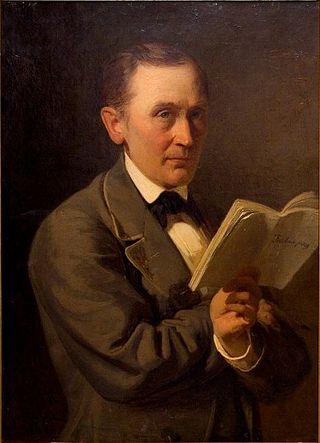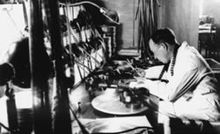
The film industry in Germany can be traced back to the late 19th century. German cinema made major technical and artistic contributions to early film, broadcasting and television technology. Babelsberg became a household synonym for the early 20th century film industry in Europe, similar to Hollywood later. Early German and German-speaking filmmakers and actors heavily contributed to early Hollywood.

The cinema of China is the filmmaking and film industry of the Chinese mainland under the People's Republic of China, one of three distinct historical threads of Chinese-language cinema together with the cinema of Hong Kong and the cinema of Taiwan. China is the home of the largest movie and drama production complex and film studios in the world, the Oriental Movie Metropolis and Hengdian World Studios. In 2012 the country became the second-largest market in the world by box office receipts. In 2016, the gross box office in China was CN¥45.71 billion. China has also become a major hub of business for Hollywood studios.

An independent film, independent movie, indie film, or indie movie is a feature film or short film that is produced outside the major film studio system in addition to being produced and distributed by independent entertainment companies. Independent films are sometimes distinguishable by their content and style and how the filmmakers' artistic vision is realized. Sometimes, independent films are made with considerably lower budgets than major studio films.

Konstantin Päts was an Estonian statesman and the country's president from 1938 to 1940. Päts was one of the most influential politicians of the independent democratic Republic of Estonia, and during the two decades prior to World War II he also served five times as the country's State Elder. He carried out a self-coup on 12 March 1934. After the 16–17 June 1940 Soviet invasion and occupation of Estonia, Päts remained formally in office for over a month, until he was forced to resign, imprisoned by the new Stalinist regime, and deported to the USSR, where he died in 1956.
An educational film is a film or movie whose primary purpose is to educate. Educational films have been used in classrooms as an alternative to other teaching methods.

Nazism made extensive use of the cinema throughout its history. Though it was a relatively new technology, the Nazi Party established a film department soon after it rose to power in Germany. Both Adolf Hitler and his propaganda minister, Joseph Goebbels, used the many Nazi films to promote the party ideology and show their influence in the burgeoning art form, which was an object of personal fascination for Hitler. The Nazis valued film as a propaganda instrument of enormous power, courting the masses by means of slogans that were aimed directly at the instincts and emotions of the people. The Department of Film also used the economic power of German moviegoers to influence the international film market. This resulted in almost all Hollywood producers censoring films critical of Nazism during the 1930s, as well as showing news shorts produced by the Nazis in American theaters.

Cinema of Europe refers to the film industries and films produced in the continent of Europe.
Fred Olen Ray is an American film producer, director, and screenwriter of more than 200 low-to-medium-quality feature films in many genres, including horror, science fiction, action/adventure, erotic thrillers, crime dramas, and holiday films.

Cinema of Estonia is the film industry of the Republic of Estonia. The motion pictures have won international awards and each year new Estonian films are seen at film festivals around the globe.

The cinema of Somalia refers to the film industry in Somalia. The earliest forms of public film display in the country were Italian newsreels of key events during the colonial period. In 1937 the film Sentinels of Bronze was produced in Ogaden Somalia, with nearly all Somali actors. Growing out of the Somali people's rich storytelling tradition, the first few feature-length Somali films and cinematic festivals emerged in the early 1960s, immediately after independence. Following the creation of the Somali Film Agency (SFA) regulatory body in 1975, the local film scene began to expand rapidly. In the 1970s and early 1980s, popular musicals known as riwaayado were the main driving force behind the Somali movie industry. Epic and period films as well as international co-productions followed suit, facilitated by the proliferation of video technology and national television networks. In the 1990s and 2000s, a new wave of more entertainment-oriented movies emerged. Referred to as Somaliwood, this upstart, youth-based cinematic movement has energized the Somali film industry and in the process introduced innovative storylines, marketing strategies and production techniques.

Arab cinema or Arabic cinema refers to the film industry of the Arab world. Most productions are from the Egyptian cinema. Currently, the Middle East's largest cinema chain is Vox, owned by UAE-based Majid Al Futtaim Cinemas.

The culture of Estonia combines an indigenous heritage, represented by the country's Finnic national language Estonian, with Nordic and German cultural aspects. Over the centuries, the culture of modern Estonia has been significantly influenced by that of the Germanic-speaking world. Due to its history and geography, Estonia's culture has also been influenced by the traditions of the Baltic Germans and Scandinavians as well as the neighbouring Baltic, Slavic, and Finnic peoples.
Tallinnfilm is the oldest surviving film studio in Estonia. It was founded as Estonian Culture Film in 1931, and was nationalized in 1940 after Estonia was integrated into the Soviet Union. During the first year of Soviet Occupation (1940–1941) Eesti Kultuurfilm was taken over by the Communist Party and renamed Kinokroonika Eesti Stuudio. In 1942 during the German occupation the studio was renamed Kinokroonika Tallinna Stuudio and then renamed again as Tallinna Kinostuudio in 1947 by the Soviets. The Tallinn Film Studio was renamed Kunstiliste ja Kroonikafilmide Tallinna Kinostuudio in 1954 and in 1963 was renamed again Tallinnfilm.

The cinema of Moldova developed in the early 1960s during the Soviet period, experiencing a flowering of about a decade and a half. Stagnation followed, and after the Moldavian SSR became independent in 1991, the industry almost completely disappeared.

Baltic Film, Media and Arts School of Tallinn University (BFM) is a film and media school created in 2005 as a college of Tallinn University.

Estonia, officially the Republic of Estonia, is a country by the Baltic Sea in Northern Europe. It is bordered to the north by the Gulf of Finland across from Finland, to the west by the sea across from Sweden, to the south by Latvia, and to the east by Lake Peipus and Russia. The territory of Estonia consists of the mainland, the larger islands of Saaremaa and Hiiumaa, and over 2,300 other islands and islets on the east coast of the Baltic Sea, covering a total area of 45,335 square kilometres (17,504 sq mi). Tallinn, the capital city, and Tartu are the two largest urban areas. The Estonian language is the official language and the first language of the majority of the population of 1.4 million.

Cinema of South India, refers to the cinema of the four major film industries in South India; primarily engaged in making feature films in the four major languages of the region, namely — Telugu, Tamil, Malayalam and Kannada. They are often colloquially referred to as Tollywood, Kollywood,Mollywood and Sandalwood, respectively.
Java Pacific Film was a short-lived film production company that helped make significant contributions to Indonesian cinema in the 1930s.

Chocolala Chocolate Museum is a specialty museum dedicated to the history of the Estonian chocolate industry. It is located in the Tallinn Old Town district near Freedom Square, Tallinn, Estonia.
Cinema of Sudan refers to both the history and present of the making or screening of films in cinemas or film festivals, as well as to the persons involved in this form of audiovisual culture of the Sudan and its history from the late nineteenth century onwards. It began with cinematography during the British colonial presence in 1897 and developed along with advances in film technology during the twentieth century.















